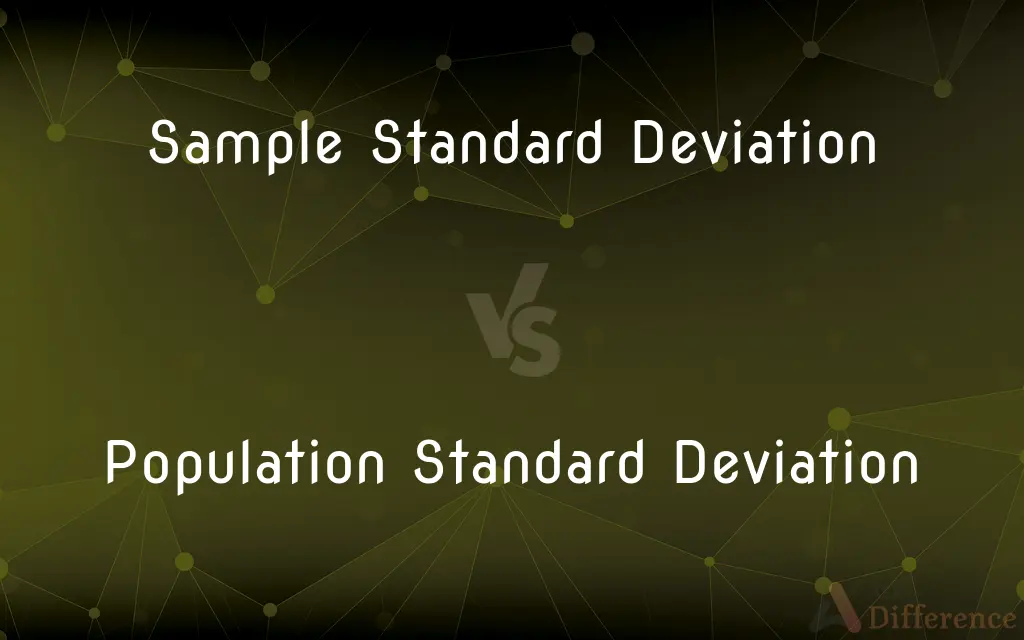Sample Standard Deviation vs. Population Standard Deviation — What's the Difference?
By Tayyaba Rehman — Published on January 6, 2024
Sample Standard Deviation estimates variability from a sample; Population Standard Deviation measures it for an entire population. Both indicate data spread.

Difference Between Sample Standard Deviation and Population Standard Deviation
Table of Contents
ADVERTISEMENT
Key Differences
Sample Standard Deviation is a statistical measure used to determine the spread or dispersion of a set of values taken from a subset or sample of a larger group. In contrast, Population Standard Deviation is employed when considering the spread of values for the whole group or entire population.
When calculating Sample Standard Deviation, one uses the formula with a divisor of "n-1", where "n" is the sample size. This is because the sample is an estimation. Conversely, Population Standard Deviation uses a divisor of "n" as it accounts for all members of the population.
The reason for using "n-1" in Sample Standard Deviation is a concept called Bessel's correction. It corrects the bias in the estimation of the population variance from a sample. On the other hand, Population Standard Deviation doesn't need this correction as it encompasses the entire set of data.
While Sample Standard Deviation is common in scenarios where it's challenging to gather data for the entire population, Population Standard Deviation is ideal when comprehensive data is accessible. Both serve the purpose of understanding variability, but their application and calculation differ.
Despite these distinctions, it's essential to recognize that both Sample Standard Deviation and Population Standard Deviation provide insights into data's dispersion. However, one must be cautious about their specific usage to ensure accurate results.
ADVERTISEMENT
Comparison Chart
Data Source
Subset or sample of a population
Entire population
Formula Divisor
N-1 (Bessel's correction)
N
Application
When full data isn't accessible
When data for the entire group is available
Bias
Contains correction for bias
No bias as it uses all data
Reflects
Estimation of the population's variability
True variability of the entire population
Compare with Definitions
Sample Standard Deviation
Uses "n-1" in its calculation due to Bessel's correction.
When computing the Sample Standard Deviation, Sally remembered to divide by n-1.
Population Standard Deviation
Represents true variability within a whole group.
Companies prefer the Population Standard Deviation when analyzing all user reviews.
Sample Standard Deviation
Frequently applied when population data is hard to obtain.
For their city survey, the team relied on Sample Standard Deviation due to limited resources.
Population Standard Deviation
Applied when comprehensive data of a group is available.
The research institute used Population Standard Deviation for their extensive study.
Sample Standard Deviation
An insight into probable population spread using limited data.
The Sample Standard Deviation suggested the new policy might face varied feedback.
Population Standard Deviation
A measure of spread for an entire set of data.
The Population Standard Deviation for national test scores was 20 points.
Sample Standard Deviation
Statistical tool estimating population variability.
Using the Sample Standard Deviation, researchers gauged the product's reception.
Population Standard Deviation
Uses "n" in its formula, accounting for all data points.
When examining global sales, Tom utilized the Population Standard Deviation.
Sample Standard Deviation
A measure of dispersion for a subset of data.
The Sample Standard Deviation for our classroom test scores was 15 points.
Population Standard Deviation
Reflects the absolute dispersion in a defined population.
Population Standard Deviation clarified the vast income disparity in the nation.
Common Curiosities
Why is Bessel's correction applied to Sample Standard Deviation?
It corrects bias when estimating population variance from a sample.
Can Population Standard Deviation be greater than Sample Standard Deviation?
Yes, values depend on data, not just formulas; either can be larger depending on the data.
When should I use Sample Standard Deviation over Population Standard Deviation?
Use Sample Standard Deviation when analyzing a subset, not the entire population.
Can I calculate Population Standard Deviation from Sample Standard Deviation?
Not directly; while related, they use different formulas and serve distinct purposes.
Is Population Standard Deviation always more accurate?
Population Standard Deviation reflects true variability for the entire group, making it accurate for that population.
In research, which standard deviation is more commonly used?
Sample Standard Deviation is often used in research due to practical limitations in data collection.
Why does Sample Standard Deviation tend to be higher?
Bessel's correction in its formula can result in a slightly higher value, but it's not a rule.
Do both types of standard deviations measure variability?
Yes, both Sample Standard Deviation and Population Standard Deviation measure data dispersion.
How does standard deviation differ from variance?
Variance is the square of the standard deviation, be it Sample Standard Deviation or Population Standard Deviation.
Why is understanding data spread important?
Both Sample Standard Deviation and Population Standard Deviation help in gauging data variability, impacting decision-making.
Which standard deviation uses a divisor of n-1?
The Sample Standard Deviation uses a divisor of n-1.
Is the choice between these standard deviations based on data size?
It's about the data's nature (whole population vs. subset) more than its size.
Can I use Population Standard Deviation for a sample?
It's not ideal; using Population Standard Deviation for a sample can lead to biased results.
Are these standard deviations affected by outliers?
Yes, both Sample Standard Deviation and Population Standard Deviation can be influenced by extreme values or outliers.
Do both types of standard deviations have units?
Yes, both have units, typically the same as the data set's units.
Share Your Discovery

Previous Comparison
Naan vs. Pita Bread
Next Comparison
Mixtures vs. CompoundsAuthor Spotlight
Written by
Tayyaba RehmanTayyaba Rehman is a distinguished writer, currently serving as a primary contributor to askdifference.com. As a researcher in semantics and etymology, Tayyaba's passion for the complexity of languages and their distinctions has found a perfect home on the platform. Tayyaba delves into the intricacies of language, distinguishing between commonly confused words and phrases, thereby providing clarity for readers worldwide.













































